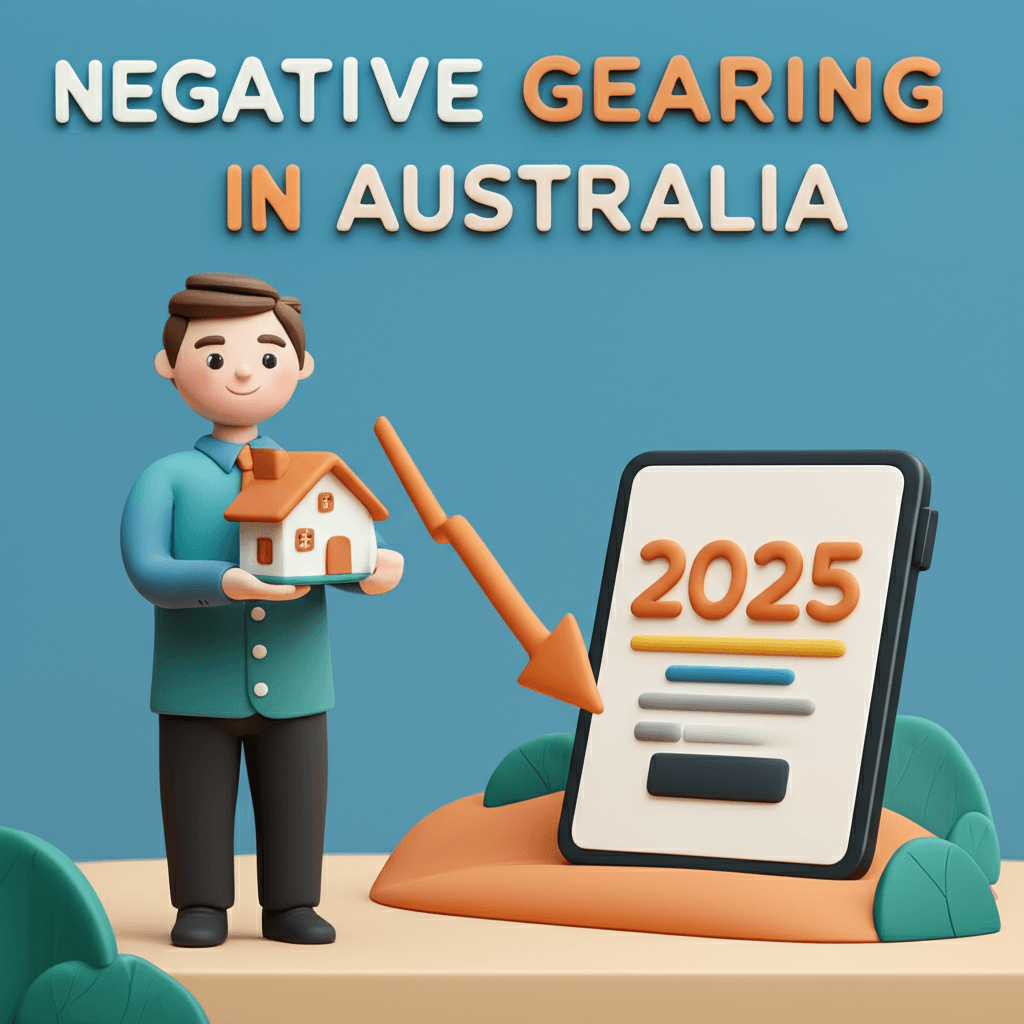Negative Gearing in Australia: A Property Investor's 2025 Guide
Understand the facts behind the headlines and learn why focusing on market fundamentals, not tax policy, is the key to long-term investment success.

Navigating the Australian property market in mid-2025 can feel overwhelming. Headlines about potential changes to negative gearing are once again causing confusion and uncertainty for investors. Should you be concerned? Will it crash the market? Or is it all just political noise?
This guide cuts through the speculation. We'll break down what negative gearing truly is, examine its real-world impact on the market, and reveal why successful investors focus on robust data and long-term strategy rather than temporary tax policies. Our goal is to empower you to make informed decisions based on fundamentals, ensuring your portfolio is built for sustainable growth.
What Exactly is Negative Gearing?
Before diving into the debate, it's crucial to understand the mechanics. At its core, negative gearing is a simple financial concept that applies to any income-producing asset, not just property.
An investment is 'negatively geared' when the costs of owning and maintaining it exceed the income it generates. For a property investor, this means the total expenses—like mortgage interest, council rates, insurance, and maintenance—are greater than the rental income received for the year.
How the Tax Deduction Works
Let's use a straightforward example:
Annual Rental Income: $30,000
Total Annual Expenses: $35,000 (including mortgage interest, property management, repairs, etc.)
In this scenario, the property has an annual cash flow loss of $5,000. This is the amount the investor must cover out of their own pocket, roughly $96 per week.
A common misconception is that the government refunds you this entire loss. In reality, the $5,000 loss can be deducted from your other taxable income. If your personal income is $100,000, this loss reduces your taxable income to $95,000.
If your marginal tax rate is, for example, 32.5%, the actual tax saving (or tax credit) you receive is 32.5% of $5,000, which equals $1,625. While this helps, you are still out of pocket by $3,375 for the year. The primary financial benefit investors seek from this strategy is not the tax deduction itself, but the long-term capital growth of the asset, which is expected to far outweigh the short-term cash flow losses.
It's important to remember this isn't a property-specific loophole; it's a fundamental principle of Australian tax law. As the Australian Taxation Office (ATO) outlines, expenses incurred in generating income are generally deductible. This applies whether you're running a small business, investing in shares, or owning a rental property.
The Political Firestorm: Why is This a Recurring Debate?
Negative gearing has been a political football for decades. It was briefly abolished between 1985 and 1987, only to be reinstated after significant rent increases were observed in major markets like Sydney and Perth. The debate resurfaced prominently before the 2019 federal election, creating significant market uncertainty.
The core argument against negative gearing is that it primarily benefits wealthier Australians and inflates property prices, locking first-home buyers out of the market. Proponents, however, argue that it is essential for stimulating the supply of rental properties, keeping a lid on rents, and encouraging private investment in housing.

While data shows that high-income earners receive a larger tax benefit in dollar terms, the majority of property investors are not ultra-wealthy moguls. Statistics consistently show that around 70% of Australian property investors own only one investment property. These are often everyday Australians—teachers, nurses, and tradespeople—trying to build financial security for their retirement.
The narrative that investors are the primary cause of unaffordability is also overly simplistic. Owner-occupiers vastly outnumber investors in the market (roughly two to one) and are often the biggest drivers of price growth, purchasing for lifestyle reasons and frequently paying a premium. Scapegoating investors is often a convenient political tactic that distracts from more complex issues like housing supply and infrastructure.
The Real-World Impact: What Happens if Negative Gearing is Removed?
To understand the potential consequences, we can look at historical precedent and examples from other countries.
The New Zealand Experiment
In 2019, New Zealand moved to phase out negative gearing to address housing affordability. The result? Rents did not fall; in fact, they continued to climb sharply. The policy change made property investing less attractive, leading some investors to sell and discouraging new investment. This reduction in the supply of rental properties, coupled with ongoing demand, put upward pressure on rents. In 2024, the New Zealand government began reinstating interest deductibility for landlords, acknowledging the policy's unintended consequences.
This outcome is logical. If investing in residential property becomes less financially viable:
1. Reduced Supply: Fewer investors will purchase properties, and some existing landlords may sell. This shrinks the overall pool of available rental homes. 2. Developer Hesitation: Property developers, seeing reduced demand from investors who often buy new builds, may scale back projects, further constraining future housing supply. 3. Increased Rents: With fewer rental properties available to a growing population, vacancy rates drop and rents inevitably rise. The market balances itself, but renters are the ones who pay the price.
Ultimately, abolishing negative gearing would likely lead to a market where most investment properties become cash-flow positive due to higher rents. The fundamental driver of property value—supply and demand—remains unchanged.
Invest for Growth, Not Tax Breaks: A Smarter Strategy
Focusing on tax deductions is a poor investment strategy. The goal of investing should be to increase your income and net worth, which naturally means paying more tax, not less. The real engine of wealth creation in property is long-term capital growth.
Rather than worrying about shifting political policies, savvy investors focus on the fundamentals. This is where a data-driven approach becomes indispensable.

Harnessing Data for Superior Decisions
Instead of chasing tax benefits, concentrate on identifying properties with strong growth potential. This involves deep analysis of market drivers.
Capital Growth Drivers: Use comprehensive [real estate analytics](https://houseseeker.com.au/features/real-estate-analytics) to track historical performance, demographic shifts, infrastructure spending, and supply-demand dynamics in different suburbs.
Rental Demand: Look for areas with consistently low vacancy rates, a diverse local economy, and population growth. These factors ensure your asset remains in high demand.
Strategic Asset Selection: Your strategy shouldn't be about finding a negatively geared property. It should be about finding the right property. Whether your goal is high capital growth, strong rental yield, or a balanced approach, an [AI Buyer's Agent](https://houseseeker.com.au/features/ai-buyers-agent) can help align your search with your specific financial goals, moving beyond generic advice.
Efficient Search: Cut through the noise of thousands of listings. An [AI property search](https://houseseeker.com.au/features/ai-property-search) allows you to use natural language to find homes that match precise criteria, such as "a house with granny flat potential in a high-growth suburb near public transport," focusing your efforts on assets with true potential.
Conclusion: Look Beyond the Noise
Negative gearing is a complex and politically charged topic, but for the strategic investor, it should be a secondary consideration. The Australian property market's long-term trajectory is driven by powerful fundamentals like population growth and chronic undersupply, not by tax policy tweaks.
History has shown that tampering with negative gearing can have unintended consequences, often leading to higher rents and doing little to solve affordability. The key takeaway is this: do not let the political debate derail your investment journey. A property that is only a good investment because of a tax deduction is not a good investment at all.
Focus on what you can control: your strategy, your research, and your selection criteria. By prioritizing assets with strong capital growth prospects and solid rental demand, you build a resilient portfolio that can thrive regardless of which way the political winds blow.
Ready to move beyond the headlines? Discover how to make smarter, data-backed decisions with HouseSeeker's [powerful real estate analytics](https://houseseeker.com.au/features/real-estate-analytics) and uncover investment opportunities based on data, not debate.
Frequently Asked Questions
Is negative gearing a scheme just for property investors?
No, it's a general principle of Australian tax law. If you incur a loss while trying to generate income from any asset—be it a share portfolio, a small business, or a property—that loss can typically be offset against your other income. It is not a special rule created for the property sector.
What would happen to my existing investment properties if negative gearing were abolished?
Historically, when major policy changes are proposed, they often include 'grandfathering' clauses. This means the old rules would continue to apply to properties purchased before a certain date. However, this is entirely dependent on the specific legislation proposed at the time.
Should I deliberately avoid buying a negatively geared property?
The cash flow of a property is just one metric. A property might be negatively geared in its early years due to high loan-to-value ratios but possess outstanding potential for capital growth. The decision should be based on a holistic analysis of the property's long-term financial prospects and whether you can comfortably service the cash flow shortfall during the initial holding period.
